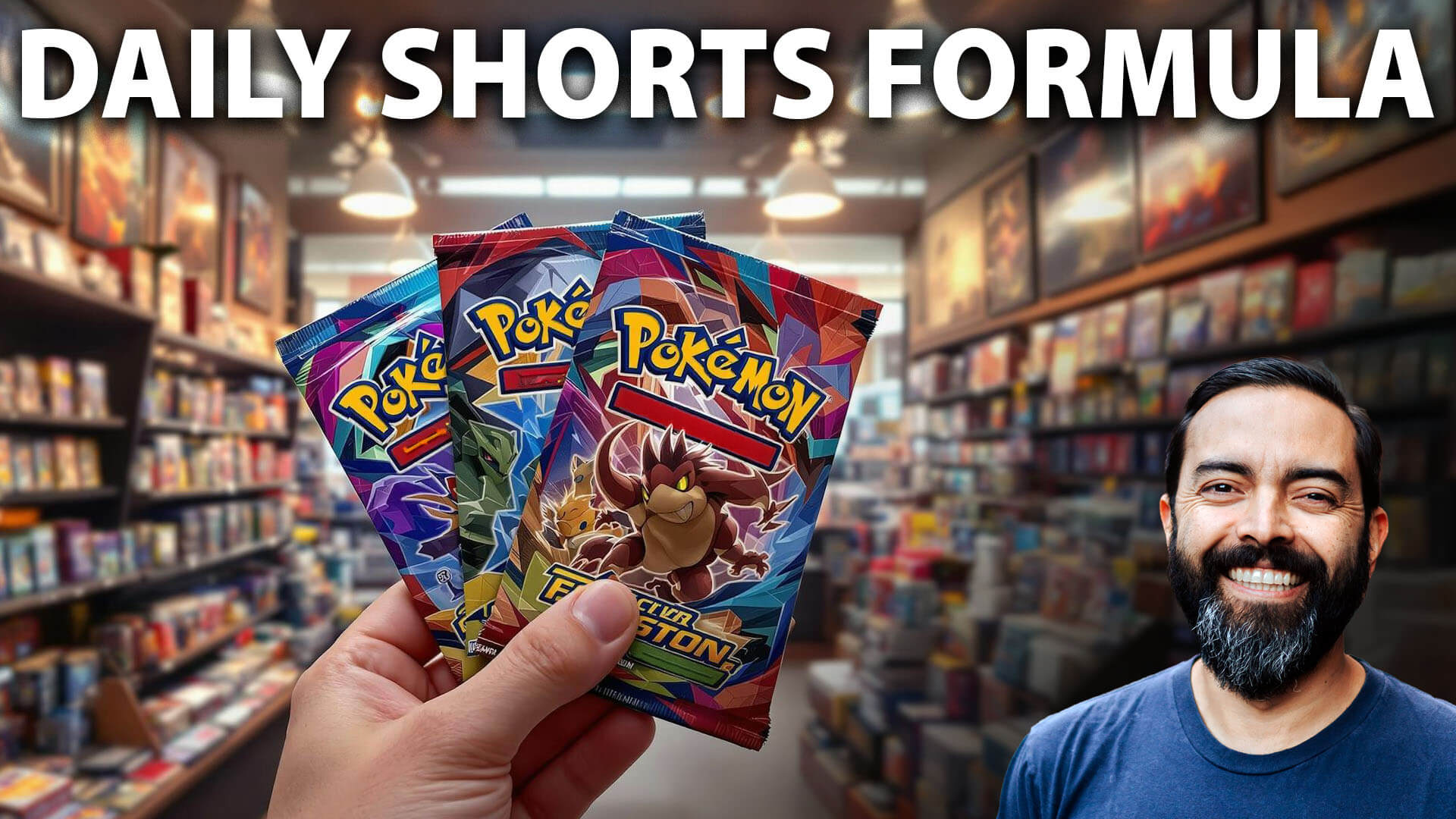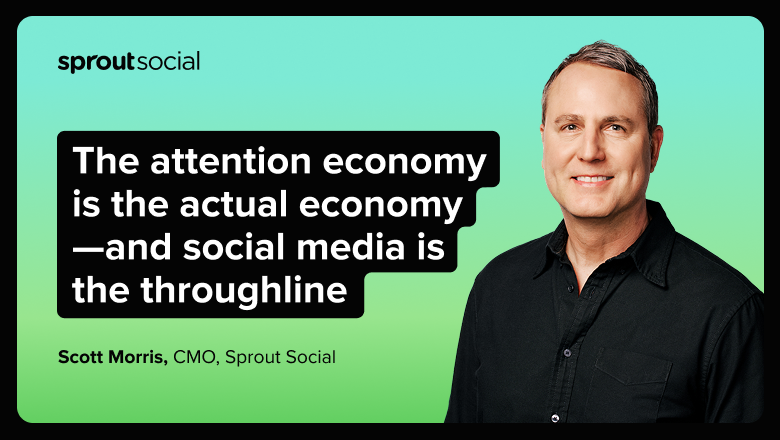Social SEO: Guide to more reach on social media + free tool
Find out what social SEO means, why it matters, and — most importantly — how it can help you grow your business accounts on all social media platforms. The post Social SEO: Guide to more reach on social media + free tool appeared first on Social Media Marketing & Management Dashboard.

Social SEO is the practice of optimizing your social content to help people find you when they search on social media platforms.
SEO stands for search engine optimization. Social networks may not technically be search engines — but people are increasingly using them the way they used to use Google.
There has been a seismic shift in search behaviors, especially among younger people.
Recent research from Forbes Advisor and Talker Research found that Generation Z is 30% less likely to use search engines for brand discovery than Baby Boomers are. Nearly a quarter of people of all ages (24%) said they only or primarily use social media for online search. Among Gen Z, that number rises to 46%.
Even more important, 21% of Gen Z starts their brand searches on social media. 44% of Gen Z finds new brands on social media every single day.
People are actively using social platforms to look for information. Social SEO helps your content rise to the top of the results.
What’s the difference between social SEO and social algorithms?
We just said that social SEO helps you reach people who are actively searching for content or products like yours on social platforms. They have typed a query into a search bar in hopes of surfacing something specific.
On the other hand, social algorithms serve up content to people who are passively scrolling through their social feed.
Understanding the algorithms and optimizing for social search are both ways to improve brand visibility and discoverability on social platforms. But SEO is particularly useful because it connects you with people at the exact moment that they want to hear from brands like yours.
How to optimize your social profiles for SEO
A quick heads-up here. This post focuses on how to improve your search results on social platforms. The main benefit is, like we said, reaching the growing audience that uses social search. But optimizing your social profiles with SEO best practices has an added off-platform benefit.
Consistent, credible, and SEO-optimized social profiles rank highly in traditional search engines like Google, too. When you create your profiles with SEO in mind, you boost your content visibility in two ways. First, to people who search on the social platforms (mainly Millenials and Gen Z) but also to people who search elsewhere.
For instance, look at the first two Google search engine result pages (SERPs) for Smitten Kitchen. After their own website content, it’s all social profiles and social media posts.
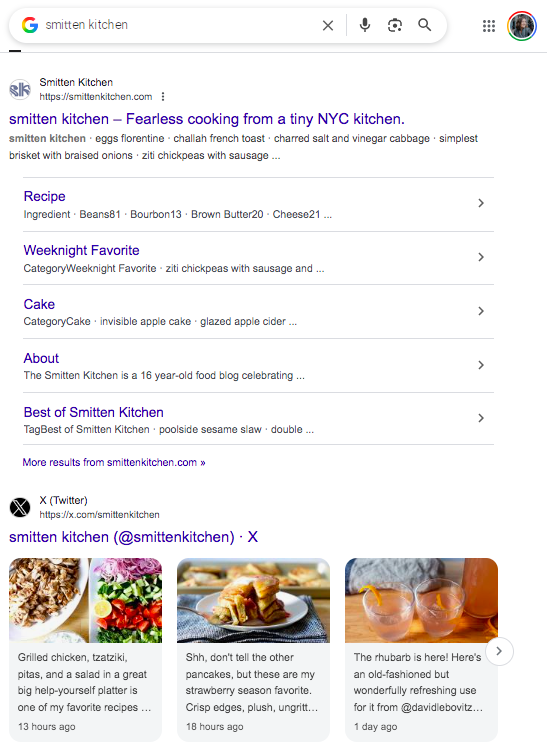
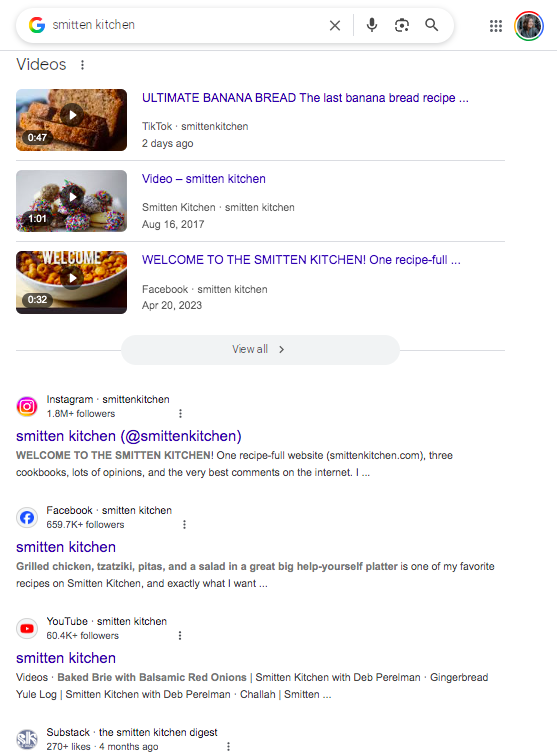
Source: Google search results for “Smitten Kitchen”
Social SEO helps you connect with audiences across the generations, no matter where they start their brand search. Here’s how to optimize your profile.
Profile information
Use all the available fields in every social profile to your advantage:
- Username/handle: Use your business or brand name, or the version of your brand name people are most likely to use when they search for you. If there’s room for a relevant keyword, consider adding it.
- Name/Page title: Include keywords related to your social media content, phrased in a natural way
- Bio/About section: Use keywords that provide context about your account. Aim for relevance to your overall brand vision or content strategy.
- Address/location: If relevant, always add your business address to your social profiles. This helps your content show up in social searches related to a specific city or geographic area. It helps your brand appear in local search results in traditional search engines, too.
For more details, check out or post on how to optimize your social profiles.
Links
The prevailing wisdom used to suggest that it was a good idea to switch up your “link in bio” pretty regularly. The idea was that this allowed you to drive traffic through to your latest blog post or campaign, keeping things fresh.
However, this is not a great strategy if your focus is on social SEO. As you’ll see below, consistency is critical in helping platforms (both social platforms and regular search engines) understand what your account is all about. Keeping your bio link consistent helps search engines understand the connection between your social profiles, your brand, and your other web content.
A good way to get around this while still being able to link to new content or campaigns is to use a custom link hub with a tool like Hootbio.
Cover and profile photos
Good cover and profile photos help establish your social account’s credibility and quality. These are important ranking factors for both social platforms and traditional search engines.
Your profile photo also appears next to your account in the social search results. So, it helps signal credibility to users, too, making them more likely to click.
Always remember that ranking high in the search results is only useful if people actually click on the result! A good, easily identifiable profile photo makes this more likely to happen.
Consistency
Search engines love consistency. It helps their ranking engines understand what’s happening on a social page, and how that page is related to other content across the web. That’s all important information for the search algorithms as they work to match content to search intent.
This means you’ll have better luck with social SEO if you stick to consistent themes and content pillars on your social accounts. We’ll get into the details of how to set this up later in this post. But for now, just remember that you’ll have better social SEO (as well as more loyal followers) if your account has a clear purpose. Stick to content that resonates with that theme.
Verification badge
As you’ll see below, Meta specifically says that buying into their Meta Verified program includes the benefit of search optimization on Facebook and Instagram.
But that’s not the only reason to pursue a verification badge.
A verification badge is an important social signal of credibility and legitimacy, both to users and to search engines.
“Our Facebook verification unexpectedly proved most valuable for local SEO,” said Matt Harrison, VP of Global Operations & Marketing at Authority Builders. “Our local search visibility improved notably because the verified status helped establish our business as a legitimate entity across the digital ecosystem.”
How to optimize your content for better discoverability
Now that you’ve got the profiles on your social media accounts sorted, let’s look at how to create a valuable content strategy for SEO.
Keyword research
Any social media SEO strategy must begin with a solid foundation of keyword research. But don’t simply choose keywords based on how you think people will search for your content. Instead, you need to understand how people actually search for content like yours.
Some good tools to get you started are:
- Hootsuite Listening: This tool uses AI to analyze millions of conversations across social media and the web. It identifies trending hashtags and top themes you can use to create keyword clusters. A handy keyword cloud can help you find related content areas.
- SEM Rush Keyword Magic Tool: Enter a keyword related to your content and this tool will generate a list of additional keyword and key phrase suggestions.
- Ahrefs Keyword Generator: This is another great tool for uncovering new and more specific keywords based on the keywords that already work for you.
- Each social network’s search bar: Within each social network, start typing a keyword phrase and see what the suggested autocompletions are.

Choosing content pillars
Going down the keyword rabbit hole can sometimes provide more results than you know what to do with. To keep you focused, it’s a good idea to create content pillars. These are key themes, topics, or content clusters. You should be able to map all the content you create back to one of your content pillars.
In the context of social SEO, think of your content pillars as keyword buckets. Take that big list of keywords and try to group or categorize them in a meaningful way. What themes emerge? How can you map those back to your larger social media marketing strategy?
You don’t need to ditch a promising keyword just because it doesn’t fit into one of your content pillars. In fact, this situation might suggest your content pillars need revisiting. However, in general, staying true to your content pillars helps search engines recognize the topics where you are a credible source and worthy of a higher rank.
The point is just to make sure you keep your keywords focused and tie them back to your social strategy rather than running away with a term that doesn’t serve you just because it has high search volume.
Tip: If Gen Z is your target audience, think about ways to link your content pillars to some of their most-search topics on TikTok and Instagram.
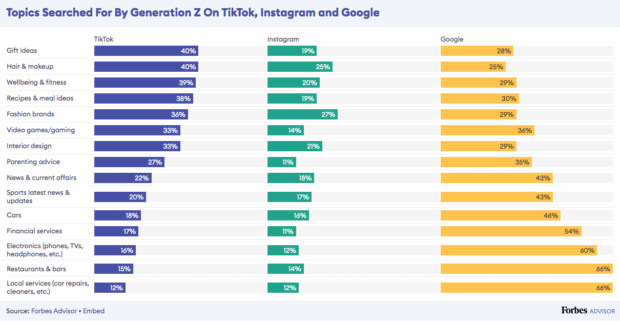
Source: Forbes Advisor
Creating posts and captions
When you decide to focus on social SEO, there needs to be a shift in the way you think about content creation. Rather than choosing keywords and hashtags that fit your content, create content designed to fit the keywords surfaced in your research.
Then, make sure to use all aspects of your post to focus on one keyword cluster.
You might want to include both a general keyword (like “pet products”) for general reach as well as a more niche one (like “poodle shampoo”) to be more targeted. But your caption, image, hashtags, voiceover, and text overlays all work together to help the search robots understand what your post is about. Keep them focused on variations of a single keyword theme.
But don’t get carried away here. Stuffing too many keywords or hashtags into your content annoys both social media users and search robots. Use keywords in a natural way. Incorporate them into sentences that sound like they could be spoken by a real human. And keep the hashtags to a minimum – aim for 3 to 5.
For a couple of bonus ways to include target keywords in your social content, try text-based images (like infographics) and text overlays on videos. And be sure to say your primary keyword out loud in any social videos.
Tip: Hootsuite has a free hashtag generator tool that will show you the best hashtags for each platform based on your content description and keywords.
Just pick a language, describe your content, add keywords, and you’ll get 10 AI-generated hashtags to use in your post.
Please note: This tool may display inaccurate or offensive material that doesn’t represent Hootsuite’s views. You’re solely responsible for use of any content generated using this tool, including its compliance with applicable laws and third-party rights.
The importance of alt text and subtitles
Alt text and subtitles are primarily accessibility features that help make your content more useful for a larger range of people. But they are also great tools for helping the social platforms understand what your content is about.
The platforms auto-generate alt text for you using image recognition software, but it is often very generic. Edit the alt text under the accessibility options when creating a post. Include your primary keyword, but make sure what you write still accurately describes what’s in the photo. This needs to be a clear image description rather than a bonus caption.
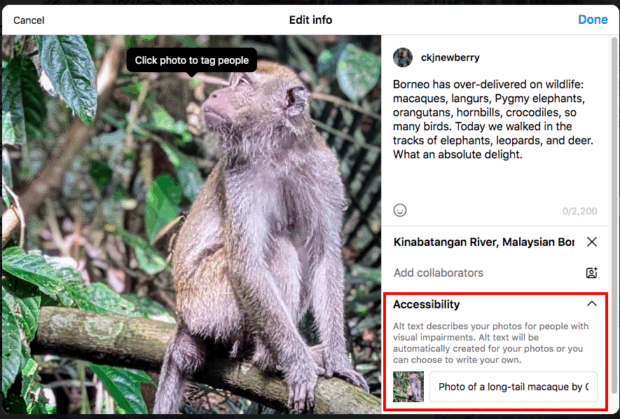
Source: @ckjnewberry
For video, turn on subtitles, and make sure to say your primary keyword out loud during your voiceover.
Lean into short-form video content
About a year ago, Google added a Short Videos tab to its search results, joining the Videos tab that’s been available for years.
Here’s why this is extremely important for marketers focused on social SEO. The Videos tab contains some content from Instagram, Facebook, and other sources but it’s quite heavily populated with YouTube Videos.

Source: Google search results (Videos tab)
However, the Short Videos tab serves up loads of videos from Instagram, TikTok, and Facebook in addition to YouTube shorts.
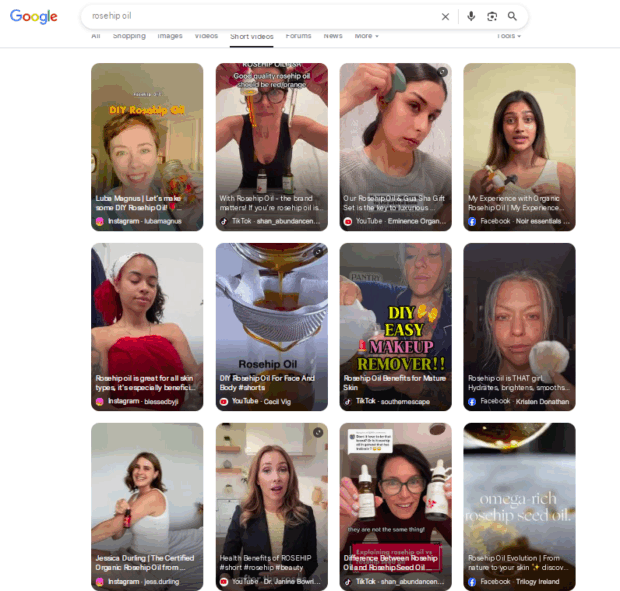
Source: Google search results (Short Videos tab)
That means creating SEO-optimized short-form videos like TikToks and Reels is another good way to get your content into traditional search results, as well as social search.
Platform-specific SEO strategies
In addition to the overarching tips listed above, here are some platform-specific tactics to include in your social SEO strategy.
Facebook SEO
- If you have multiple bricks-and-mortar locations, add a location page for each shop or office to increase all of their chances of appearing in local search.
- Get verified: Meta Verified specifically lists search optimization as a benefit of the program.
For more, check out our complete guide to Facebook SEO.
Instagram SEO
- Include Reels in your strategy, since they provide the opportunity to include keywords in captions and subtitles.
- Engage with accounts that already rank for your keywords, to help Instagram understand what your account is all about.
- Get verified: Meta Verified specifically lists search optimization as a benefit of the program
- Tip: Hiding hashtags in the comments is no longer effective and does not contribute to SEO. Keep them in the caption instead.
For more in-depth Instagram SEO strategies, check out our full blog post on Instagram SEO.
TikTok SEO
- Use your keywords in onscreen text and headlines, as well as all the other usual places.
- Say your keywords out loud, which actually gives two search signals, since the keyword then also appears in your auto-captions.
- Try using keywords in your comments.
We’ve got even more on TikTok SEO in our complete guide.
LinkedIn SEO
- Complete all available and relevant sections of your Pge, There are more of them than on other platforms, but it’s worth the time for the extra keyword opportunities.
- Create long-form content based on relevant keywords.
- Tip: It’s really important here not to overdo it. LinkedIn sorts posts right off the bat as spam, low-quality, or high-quality content. Include keywords in a natural way (rather than stuffing) and only include truly relevant hashtags.
Optimizing your business Page? Check out our LinkedIn SEO guide for even more info.
Pinterest SEO
- When setting up the structure of your account, use your primary keywords to guide the boards you create and name them accordingly.
- Build Pins around long-tail keywords such as “How to build a DIY bookcase” rather than “DIY Bookcase” or even “Build a DIY Bookcase.”
- Use high-quality images to benefit from visual search. Pinterest Lens allows users to search with their camera rather than their keyboard. High-quality, relevant images ensure you don’t miss out on these searches.
Pinterest itself is a powerful visual search engine, so if it’s your primary social channel, check out our top 10 tips to Pinterest SEO.
YouTube SEO
YouTube is definitely the social platform that functions most like a search engine. This is no surprise, since it’s a Google product.
- Use your primary keyword phrase as the video file name. For example, DIY-bookcase.mov
- In the title, use a long-tail keyword that people might type into YouTube’s search bar, such as “how to build a DIY bookcase”
- Use your primary keyword within the first two lines of the video description, which are visible without clicking more.
- Include a secondary keyword or two later in the description if you can do so without making it sound like keyword stuffing.
- Say your keywords in the video and turn on captions.
- Include keywords in tags, title cards, overlays, and video chapters/timestamps.
- Create how-to videos. How-to videos get most of their views from search, whereas other types of videos get most of their views from the home page, suggested videos, or playlists.
Find more details (and useful tools!) in our full post on YouTube SEO.
X (Twitter) SEO
As you saw in the Smitten Kitchen example above, Google indexes public X posts, and they can appear quite high in the search rankings.
- You don’t have a lot of characters to work with in X posts, so focus on short but highly relevant keywords that fit naturally into your post content.
- If you have an X Premium+ account, use X articles to create content with more keywords or longer-tail keywords.
Learn more in our top tips for managing Twitter SEO.
Traditional SEO tactics social media managers should steal
Cross-promotion
The most common form of cross-promotion on social media happens when a brand collaborates with an influencer. Both accounts can then share content from the partnership on their accounts.
This results in an expanded audience for both accounts. But it also benefits SEO by helping to establish credibility and build trust through association with a recognized expert in your niche. This helps the search algorithms better understand what your account is about and what topic areas you should rank for.
Cross-promotion also helps increase the number of backlinks to your accounts, posts, and web content. Link building is especially valuable for off-platform SEO.
Repurposing content
Repurposing content into different formats across social media channels and surfaces makes sense for any digital marketing strategy. On the SEO side, it gives you the chance to break a larger piece of content into more specific short pieces that target different keyword sets.
Tip: Use your long-tail keywords as the subheads in a blog post or whitepaper. Then use each of those chapters or subheads as its own social post.
Monitoring and analytics
Monitoring your results helps you understand how your SEO efforts are working, and when you might need to switch things up.
This looks a little different for social SEO than for SEO on the web. On the web, you’d be tracking where your content places on the SERPs for your targeted keywords.
On social platforms, that’s essentially impossible to do, since social SEO ties so closely in with personalized algorithms.
However, there are several social metrics that can help you understand whether your social SEO is working. Here are some key ones to track:
- Shares: Social shares are a powerful signal of credibility and function in a similar way to backlinks on the web.
- Profile visits: An increase in profile visits may be a clue that you’re showing up in more searches.
- Bounce rate: If your bounce rate is high, then you’re not setting the right expectations with your social posts. Check to make sure you’re using keywords that are truly relevant to the content your post links to.
For more details, check out our post on the top social media metrics to track.
Demand research
Demand research is all about understanding how many people are interested in specific topic areas, so that you can create content optimized with keywords that they’re searching for.
Social listening is an important strategy here. Social listening tools help you see in real time how many people are talking about a subject, as well as how they feel about that topic. You only want to create content targeting topics and keywords that lead to positive social sentiment.
In fact, Hootsuite Listening can even help you predict demand and conversation volumes months in advance.

Advanced social SEO tactics and emerging trends
Optimizing for voice search
Nearly a third of Internet users globally (31.5%) now use voice assistants every week. Within the Google App, 20% of searches are now by voice. TikTok has already been testing native voice search, and Meta allows users to speak out loud to its built-in Meta AI.
Preparing for more voice search requires leaning into long-form keywords. Voice searches tend to be more conversational. When speaking out loud, even to machines, we still like to ask questions rather than saying a few keywords.
When developing your content marketing strategy, look for questions in your demand and keyword research. Create content that answers specific questions. Really build out your conversational, long-tail keyword targeting to ride this emerging search trend.
Using AI for optimization
AI is especially useful for keyword analysis and prediction. Rather than combing through keyword reports manually, you can lean on AI-powered tools like Hootsuite Listening to get insights about what keywords you should be targeting in the next week, month, or quarter.
AI is also useful for creating captions and alt text optimized with your relevant keywords, and finding optimized hashtags. Hootsuite has a free SEO caption generator and Hashtag generator to get you started.
AI is also very useful for your content repurposing strategy. Hootsuite’s OwlyWriter AI can identify and repurpose your top-performing posts. It can even generate post ideas based on a keyword or topic, and then write posts expanding on the ideas you like best.
Using keywords in product names for social commerce
Ecommerce brands using social media storefronts can improve product search results by incorporating keywords into product names. Rather than giving your products unique names that don’t mean much, try to base them around your keywords.
Say you sell embroidery patterns for cute animals. Rather than giving those animals names, use your keywords. Be specific. Mirror the terms potential customers use in their search queries to improve product match results.
- Don’t: Stitching pattern: Nelson
- Do: Crewel embroidery narwhal pattern
Free social SEO tool
Use this free social SEO tool to generate captions optimized for better visibility in search results on social platforms.
Save time managing your social media and get your content seen using Hootsuite. Schedule and publish content, engage your audience, and measure the performance of all your accounts, across networks — all from a single dashboard. Try it free today.
The post Social SEO: Guide to more reach on social media + free tool appeared first on Social Media Marketing & Management Dashboard.














_1.jpg)











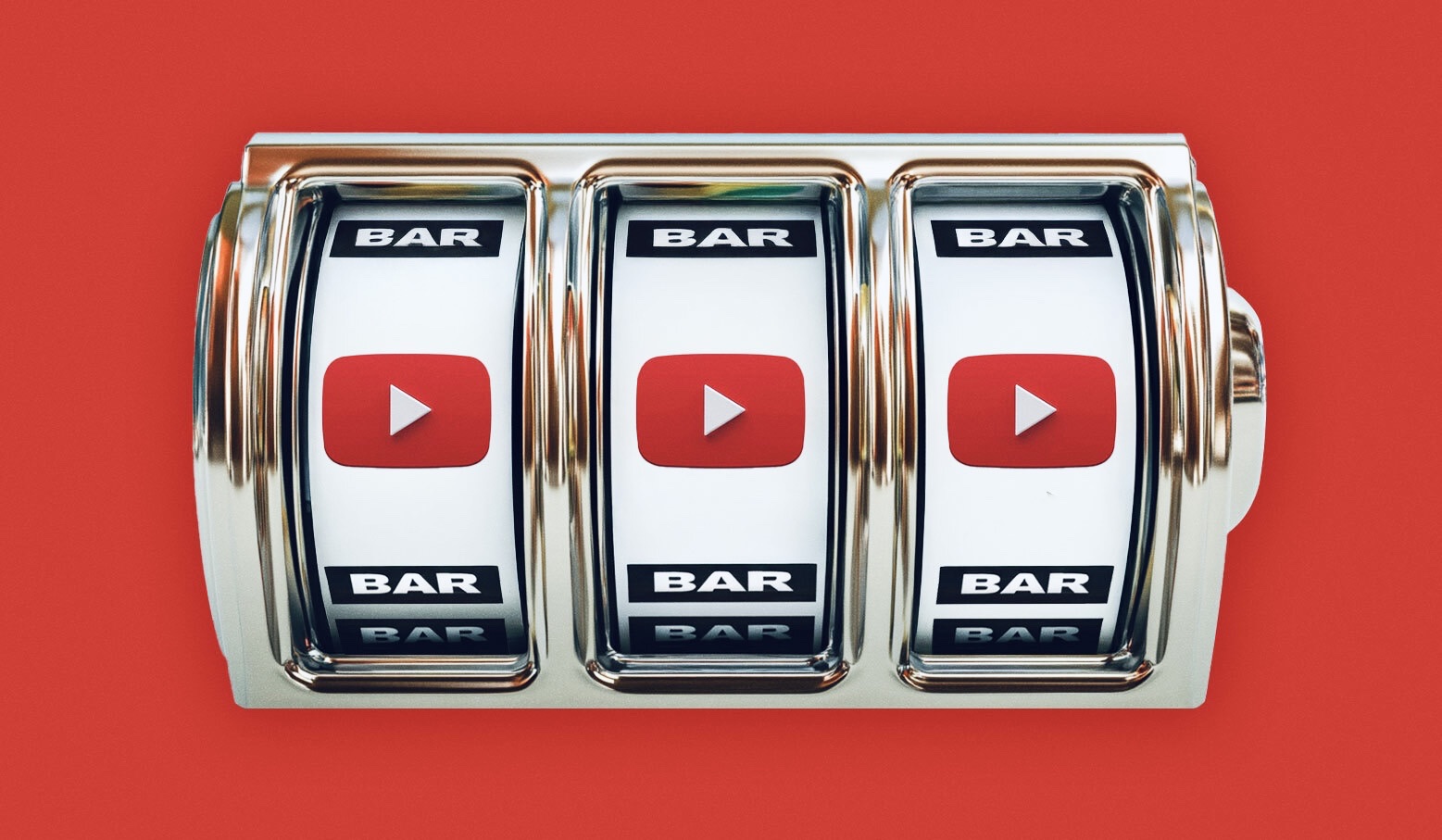

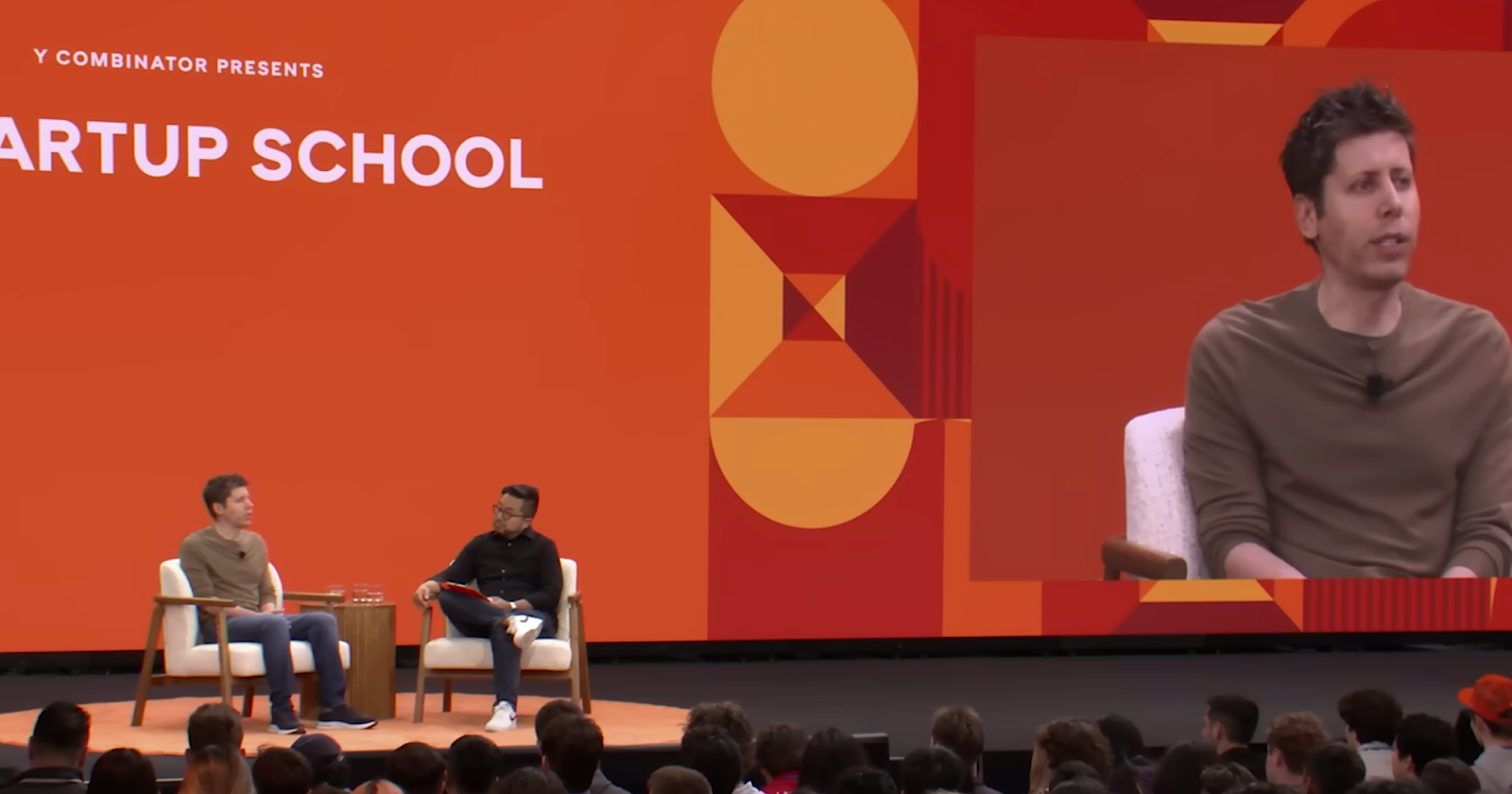


















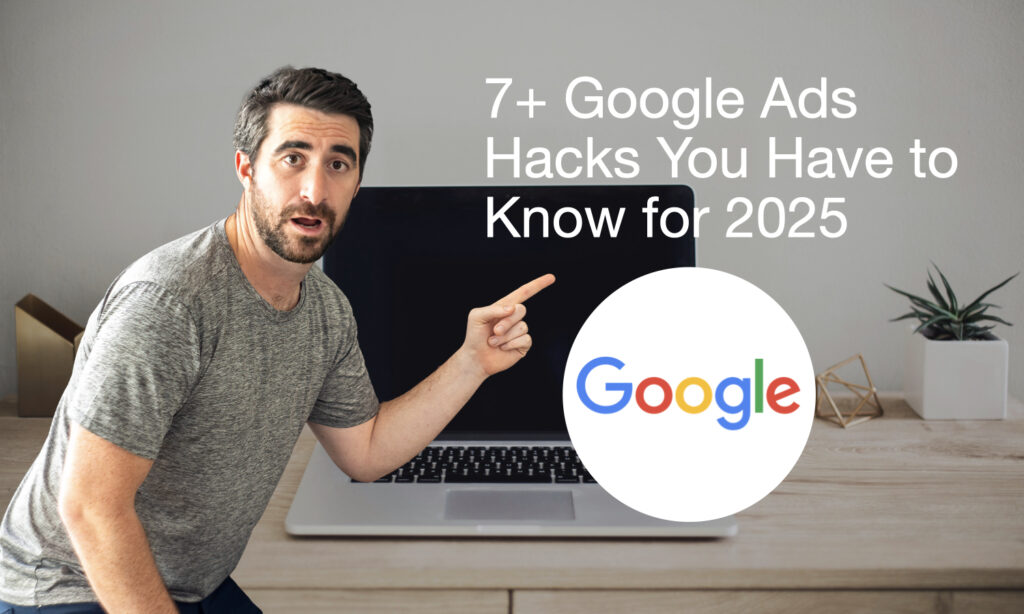


































![AI Content Is 4.7x Cheaper Than Human Content [+ New Research Report]](https://ahrefs.com/blog/wp-content/uploads/2025/06/ai-content-is-4.7x-cheaper-than-by-ryan-law-data-studies.jpg)





![Brand and SEO Sitting on a Tree: K-I-S-S-I-N-G [Mozcon 2025 Speaker Series]](https://moz.com/images/blog/banners/Mozcon2025_SpeakerBlogHeader_1180x400_LidiaInfante_London.png?auto=compress,format&fit=crop&dm=1749465874&s=56275e60eb1f4363767c42d318c4ef4a#)
![How To Build AI Tools To Automate Your SEO Workflows [MozCon 2025 Speaker Series]](https://moz.com/images/blog/banners/Mozcon2025_SpeakerBlogHeader_1180x400_Andrew_London-1.png?auto=compress,format&fit=crop&dm=1749642474&s=7897686f91f4e22a1f5191ea07414026#)
![How to Create an SEO Forecast [Free Template Included] — Whiteboard Friday](https://moz.com/images/blog/banners/WBF-SEOForecasting-Blog_Header.png?auto=compress,format&fit=crop&dm=1694010279&s=318ed1d453ed4f230e8e4b50ecee5417#)
![What Are Good Google Ads Benchmarks In 2025? [STUDY] via @sejournal, @brookeosmundson](https://www.searchenginejournal.com/wp-content/uploads/2025/06/benchmark-273.png)























![Social media image sizes for all networks [June 2025]](https://blog.hootsuite.com/wp-content/uploads/2023/01/Social-Media-Image-Sizes-2023.png)



![How marketers are navigating a possible recession (and advice about what you should do during it) [new data]](https://www.hubspot.com/hubfs/image12-May-27-2025-02-18-19-8390-AM.png)




